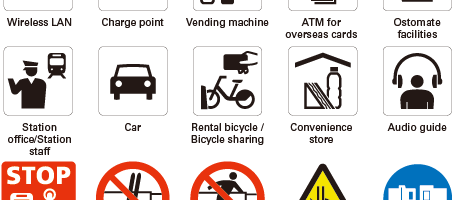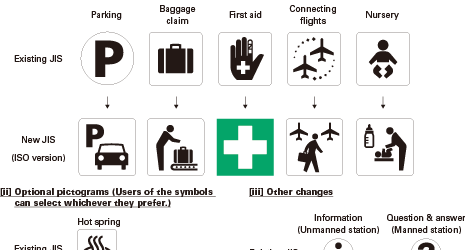Home > Highlighting JAPAN > Highlighting Japan August 2017 > The Future by Design
Highlighting JAPAN


Simpler Signs
Anticipating an increase in foreign visitors nearing the Tokyo Olympics and Paralympics in 2020, Japanese Industrial Standards (JIS) pictograms or guide signs were revised on 20 July 2017 to be simpler for not only Japanese but also foreign tourists to understand.
Pictograms are guide signs that make it possible to visually guide visitors to sites and facilities without relying on words.
Various perspectives exist regarding their origin, but the first Tokyo Olympics in 1964 is said to be the beginning of their use, which has spread worldwide. On that occasion, designer Masaru Katsumi and other members of the project team sought to solve problems related to Japanese people’s poor command of foreign languages by effectively using pictograms. In 1987, the International Organization for Standardization (ISO) adopted the Emergency exit sign developed by Sign Center President Yukio Ota and other designers as an ISO standard. This sign, created in Japan, is one of pictograms that are recognized worldwide.
Various pictograms have been newly developed to improve the comprehensibility and noticeability of guide signs or revised to suit the changing times in Japan and overseas. However, some of the pictograms used in Japan are based on the Japanese Industrial Standards, a national standard enacted under the Industrial Standardization Act. In some cases, they differ from their counterparts based on ISO standards. Those differences may sometimes confuse foreign visitors. They are, for example, pictograms for connecting flights, baggage claim, nursery, parking, first aid and so on. Such pictograms based on ISO standards can have a straightforward meaning for everyone, regardless of their native language, country or region of origin.
Managing consistency between ISO-based and JIS-based pictograms is essential for Japan as the number of foreign visitors continues to grow, even faster than forecast, ahead of the 2020 Tokyo Olympics and Paralympics.
To address such issues, the Ministry of Economy, Trade and Industry (METI), the central government office responsible for the guide signs and JIS standards, examined the results of surveys of both Japanese and foreign people prior to revision of the JIS Act. Subsequently METI revised the Act and pictograms used in Japan on 20 July 2017. On that occasion, it introduced fifteen new JIS-based pictograms and help marks (Figure 2) aimed at improving the convenience of foreign visitors, in addition to revising seven existing pictograms (Figure 1). Five pictograms in Japan, namely those for parking lots, baggage claim, aid stations, connecting flights and facilities for babies and infants (baby-care rooms), were changed to ISO-based signs in the latest revision.
METI has set a period of two years (from 20 July 2017 to 19 July 2019) for the complete transition to pictograms based on ISO standards. The revision also made the pictogram for hot springs selectable from two choices, the conventional JIS-based sign or the ISO-based sign. In addition, the meanings of information counter signs, “i,” which is described later, were adjusted.
Kunihiro Nagata, a member of the International Standardization Division of METI, explained the key points of the latest pictogram revisions as follows.
“The parties that install signs are now able to choose from a pictogram familiar to Japanese people or the ISO-based sign to indicate hot springs. We allow them to choose the appropriate guide sign based on their own assessment. Foreign visitors seem to prefer the ISO-based signs, but we’d like them also to appreciate the symbolic mark of Japanese hot-spring culture and to enjoy the hot-spring experience as part of that. In addition to pictograms that indicate locations and facilities, we have introduced help marks that express concepts. These signs allow bearers in need of assistance or consideration such as those who have artificial joints or women in the early stage of pregnancy to share their needs with the people around them.
The JIS-based signs newly introduced (refer to Figure 2) support actions in addition to indicating locations and facilities such as the signs for convenience stores and automatic teller machines (ATMs) that can accept credit cards issued overseas. “We would really like foreign visitors to be aware of these signs to better enjoy their trips to Japan,” says Nagata.
Pictograms for information counters and information centers will cater to foreign visitors in particular. Prior to the revisions, there were two types of signs for information counters in Japan, “i” and “?”. The former indicated unattended counters and the latter indicated that personnel are on duty to offer information to visitors on a full-time basis. On this occasion, METI changed the rule to use “i” for both attended and unattended counters in light of the growing international trend to use “i” for information counters of both types. Meanwhile, METI did not change the “?” sign widely used in Japan. Personnel are on duty on a full-time basis to answer various questions at counters indicated with this sign.
“We would like foreign visitors to understand the differences. We would like them to know what the “?” sign means in addition to the “i” sign,” says Nagata. “In any case, we would like them to look for the “?” sign or the “i” sign first when they come to Japan.”


© 2009 Cabinet Office, Government of Japan






